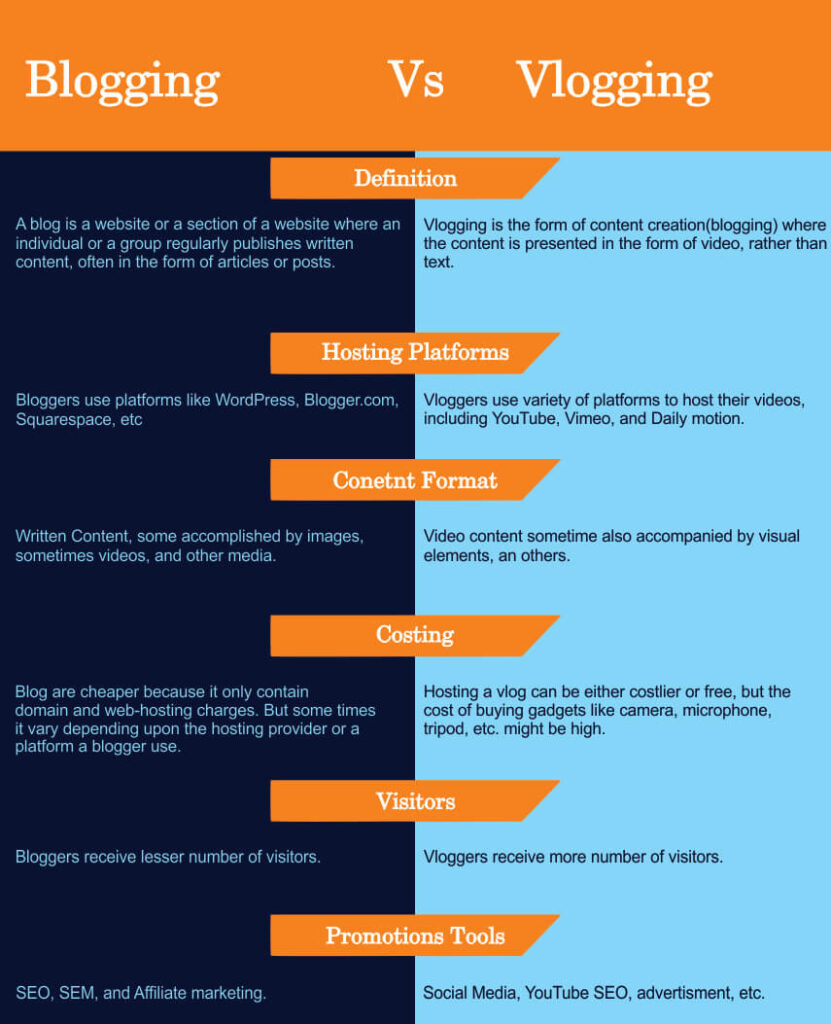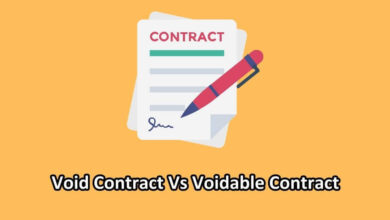Blogging and vlogging – both of them have become popular ways to share your thoughts, opinions, and experiences with the world. But there are some crucial distinctions between the two that you should be aware of if you’re considering using either one to tell your story. Read on to find out more about the differences between blogging and vlogging, complete with a handy chart for easy comparison.
You Can Also Read: Difference Between Digital Marketing and Social Media Marketing
What is Blogging?
Blogging is a form of online journaling or diary-keeping and is a way to share your thoughts and ideas with the world. A blog is simply a website that you can update regularly with new content, and most bloggers use a blogging platform such as WordPress or Blogger to make it easy to add and manage their posts.
Blogs are usually maintained by an individual with regular entries of commentary, descriptions of events, or other material such as graphics. Entries are commonly displayed in list format, with the newest posts shown first.
Moreover, blogging can be a way to keep a personal journal online but is also often used as a form of social networking or as a way to promote oneself or one’s business. Many bloggers use their blogs as a platform to express their views on current affairs or popular culture, while others use them simply as an online diary.
Top 5 Ways to Grow Your Blog
There are many ways to grow a blog, and the specific strategies that will work best for you will depend on your goals, target audience, and the type of content you publish. Here are five potential approaches you can consider.
- Create high-quality content: One of the most important things you can do to grow your blog is to consistently publish high-quality, engaging, and valuable content. This will help you attract and retain readers, as well as improve your search engine ranking.
- Promote your blog: Once you have created some content, you need to promote it in order to reach your target audience. This can be done through a variety of channels, including social media, email marketing, guest posting on other blogs, and paid advertising.
- Engage with your readers: Building a community around your blog is a great way to grow and retain readers. Engage with your readers through comments, social media, and email to build relationships and encourage them to share your content with their own networks.
- Optimize your blog for search engines: Proper search engine optimization (SEO) can help your blog appear higher in search engine results and attract more organic traffic. This involves using keywords and other SEO techniques to make your blog more attractive to search engines.
- Experiment with different formats and platforms: Consider experimenting with different formats, such as video or audio, and platforms, such as YouTube or podcasting, to reach new audiences and engage with your readers in new ways.
What is Vlogging?
Vlogging is a type of content creation that focuses on video content. Vloggers use video to share their thoughts, opinions, and experiences with their audience. Vlogging can be used to document your daily life, share your hobbies and interests, or give advice and tips on a particular topic.
Most vloggers use video editing software to enhance their videos and make them more interesting to watch. Many vloggers also use social media platforms such as YouTube, Facebook, and Instagram to promote their videos and grow their audience.
Five Ways to Grow as a Vlogger
To grow as a vlogger, you may have to apply the same techniques as a blogger do. Like:
- Create high-quality content: In order to grow your vlogs, it’s important to focus on creating engaging, informative, and entertaining content that resonates with your audience. This includes shooting high-quality video, using good lighting and sound, and organizing your content in a way that is easy for your viewers to follow.
- Engage with your audience: Building a community around your vlogs is important for their growth. Respond to comments and messages from your viewers, ask for feedback and suggestions, and participate in online forums and communities related to your vlogging niche. This can help you build a loyal following and get more subscribers.
- Promote your vlogs: In order to get more views, you’ll need to promote your vlogs on social media and other platforms. Share links to your vlogs on your personal social media accounts, and consider using paid advertising to reach a wider audience. You can also collaborate with other vloggers and influencers to reach new viewers.
- Use SEO strategies: Using YouTube search engine optimization (SEO) strategies can help your vlogs rank higher in the search engine(e.g. YouTube, Dailymotion, and others) results, making it easier for people to discover them. This can include optimizing your vlog titles, descriptions, and tags, as well as using relevant keywords in your video content.
- Consistency is key: To keep your audience coming back for more, it’s important to post new vlogs consistently. Determine a schedule that works for you and stick to it, whether it’s posting a new vlog once a week or every day. This can help you build a dedicated following and keep your vlogs growing over time.
You Can Also Read: Difference Between Data Science and Data Analytics
Main Difference
The main difference between blogging and vlogging is the format of the content. Blogs are typically written in a text format, while vlogs are filmed and edited into a video format. This means that vlogging requires more time and effort to produce than blogging. However, the rewards can be greater as well, since videos are more engaging and visually appealing than text-based content.
Blogging Vs Vlogging(Comparison Table)
The following table shows the core comparisons between blogging and vlogging.

Four Differences Between Blogging and Vlogging
It is often confusing to understand the comparison between blogging vs vlogging. They are both content creators, but there are four key differences between the two:
- The format of the content. Blogs are usually written articles. On the other hand, vlogs are video blogs. This is the most obvious difference between the two.
- The length of the content. Blogs can be any length, from a few sentences to several thousand words. Vlogs, on the other hand, are usually shorter, around 5 minutes or more.
- The frequency of posting. bloggers can post as often or as little as they want. There is no set schedule for when a new blog post must go up. Vloggers, however, must be much more consistent with their posting schedule since each video takes much longer to produce than a blog post.
- The income potential. While both bloggers and vloggers can make money from their content through advertisements or sponsorships, vloggers have a higher potential to make more money since their videos can reach a wider audience than most blogs can.
Conclusion
In conclusion, blogging vs vlogging, are two different content formats that each have their own advantages. Blogs offer a great way to share detailed information and write-ups in an organized fashion. On the other hand, vlogs are better suited for providing a visual representation of what you want to convey. Whether you choose one or the other is ultimately up to your personal preference, but it’s important to remember that both can be effective when used properly. With this new knowledge at hand, I’m sure you’re ready to start creating original content.
Reference Sites:




2 Comments